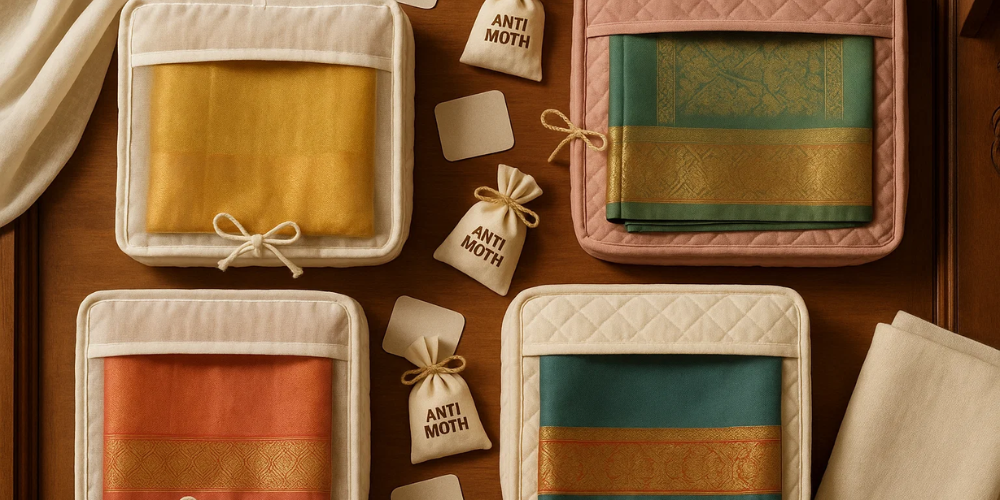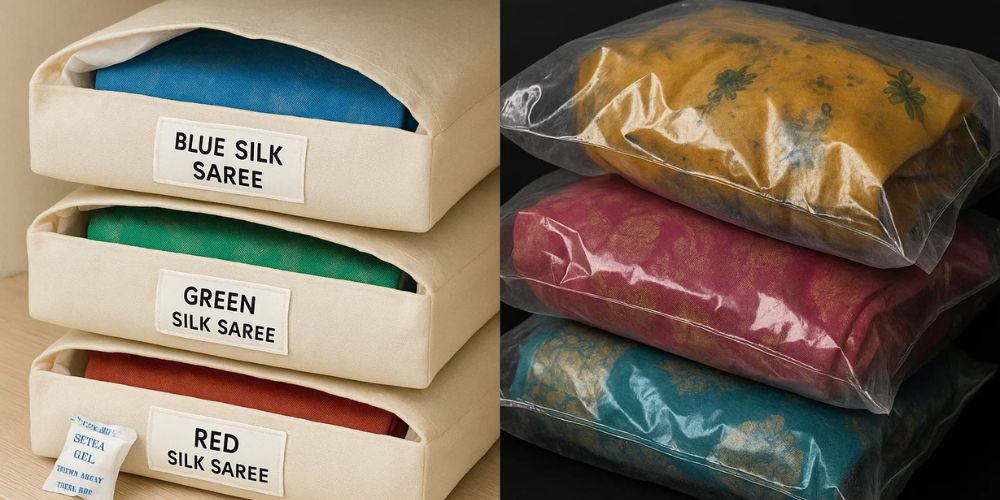In many Indian homes, silk sarees are far more than just garments; they are living pieces of tradition, woven with memory and meaning. Whether it’s the Kanjeevaram passed down from a grandmother or the Banarasi worn at a wedding, silk sarees embody cultural identity, personal milestones, and generational heritage.
However, these precious fabrics are fragile. Exposure to humidity, light, or even improper folding can cause faded colors, brittle zari borders, and permanent damage. Sadly, families often realize this only when heirloom sarees emerge from storage yellowed or moth-eaten.
Enter the silk saree storage bag, a simple, elegant solution that combines tradition with functionality. By offering protection against dust, moisture, pests, and light, these storage bags help preserve not just the fabric but the legacy woven into every thread.
The Cultural Importance of Silk Sarees
Silk sarees are the crown jewels of Indian textiles. Renowned varieties like Kanchipuram, Banarasi, Mysore silk, Muga, and Maheshwari carry regional stories through their textures, colors, and motifs. These sarees aren’t just worn, they’re celebrated on weddings, festivals, and family ceremonies, and often become heirlooms passed down through generations.
For example, the Government of India highlights that “Silk connects India’s history, tradition and art, evident in iconic silk sarees like Kanchipuram and Banarasi”. Kanchipuram silk, in particular, has a weaving legacy of over 400 years, supported by a weaving community of around 60,000 in Tamil Nadu . Each of these sarees is more than clothing, they are cultural assets, often treated with the same reverence as jewelry.
Preserving these fabrics isn’t just about maintaining their appearance; it’s about protecting a tangible piece of cultural heritage. This begins with how they’re stored.
Common Problems with Silk Saree Storage
Despite their elegance and durability, silk sarees are surprisingly vulnerable when stored improperly—especially in the diverse and often humid climates found across India. Many households unknowingly expose these garments to long-term damage by folding them the wrong way, using unsuitable packaging, or storing them in damp, airtight spaces.
Here are some of the most common silk saree storage issues:
Color Fading
When stored in areas exposed to sunlight or artificial light, silk can lose its rich vibrancy. Over time, the once-brilliant jewel tones of a saree can dull, particularly if not wrapped in light-blocking fabric.
Moisture & Mold
Humidity is silk’s silent enemy. If a saree is stored in a plastic bag or airtight container without ventilation, moisture can build up and cause mildew or mold spots. This not only stains the fabric but also creates an unpleasant smell that is hard to remove.
Pest Damage
Silk is a natural protein fiber, which makes it highly attractive to pests like silverfish and moths. These insects can chew through fabric unnoticed, especially in dark, undisturbed storage areas.
Fabric Creasing & Zari Breakage
Improper folding or stacking heavy items on top of a silk saree can lead to deep creases. For sarees with zari (metallic thread) work, these folds can eventually cause the threads to snap or tarnish.
Color Transfer
Storing multiple sarees in direct contact—especially different colors or with zari—can result in color bleeding or transfer, particularly in humid conditions.
Why Silk Saree Storage Bags Are the Answer

When it comes to preserving silk sarees, the choice of storage isn’t just a matter of organization—it’s a decision that affects the fabric’s lifespan, color, and sentimental value. That’s where silk saree storage bags step in as the unsung heroes of traditional Indian wardrobes.
Designed with fabric care in mind, these bags offer multiple layers of protection that standard suitcases, plastic bins, or polybags simply can’t match.
Breathable, Non-Acidic Fabric
Unlike plastic covers that trap moisture and emit harmful chemicals over time, high-quality saree storage bags are typically made from cotton muslin or other breathable, acid-free materials. This ensures proper air circulation while preventing yellowing or discoloration of the silk.
Protection from Light, Dust & Pests
Most silk saree storage bags come with zippered or Velcro closures that keep out dust, insects, and environmental pollutants. Many also feature interior linings treated with anti-microbial or moth-repelling finishes, adding an extra layer of safety for long-term storage.
Preserves Zari & Embroidery
Zari work is especially prone to tarnishing when exposed to air and moisture. Storage bags with soft inner linings and proper folding compartments prevent metallic thread from rubbing or breaking, ensuring that the saree retains its original brilliance.
Stackable & Space-Saving
These bags are also a win for modern storage needs. Many are slim, foldable, and stack easily in cupboards or under beds, making them ideal for both large and small wardrobes.
Travel-Friendly
If you’re carrying sarees to a wedding, destination event, or family function, silk saree storage bags help keep them wrinkle-free and protected on the go, especially when stored in suitcases with other items.
In short, silk saree storage bags offer a low-cost, high-reward way to extend the life of treasured garments. Whether you wear your sarees regularly or only for special occasions, the right storage bag acts as a barrier between your fabric and the elements that silently destroy it.
Types of Storage Bags You Can Use

Not all silk saree storage bags are made the same, and choosing the right one can make all the difference in preserving your collection. Depending on your wardrobe size, budget, and frequency of saree use, here are the most commonly used types of storage bags designed specifically to protect silk fabrics:
| Type | Features | Best For |
|---|---|---|
| Cotton Muslin Storage Bags | – Made from breathable, unbleached cotton- Allows air circulation- Gentle and moth-resistant | Heirloom sarees, handwoven silks, zari-rich fabrics |
| Quilted Zip-Up Saree Bags | – Foam padding for structure- Zippered compartments- Stackable & protective | Seasonal storage, organizing multiple sarees in one place |
| Transparent PVC/Fabric Bags | – See-through for easy identification- Some include label holders- Quick access design | Daily-use or frequently-worn sarees |
| Travel-Ready Saree Organizers | – Compact and foldable- Often moisture-resistant- Lined to prevent wrinkles | Weddings, gifting, short-term transport of special-event outfits |
When & Where You Need These Bags Most
While silk saree storage bags are great for everyday use, there are certain times in life when they become absolutely essential. For instance, during wedding season, wardrobes are in constant motion—sarees are worn, packed, gifted, or temporarily stashed in suitcases. This kind of movement increases the chances of snagging, staining, or folding damage. Having dedicated storage bags keeps each piece safe and ready to wear, no matter how hectic things get.
Similarly, if you’re moving homes or storing sarees during a seasonal wardrobe switch, storage bags act as a shield against dust, moisture, and rough handling. In India’s tropical climate, where monsoon humidity can seep into wardrobes, these bags help preserve fabric integrity while keeping pests at bay.
They also prove useful when gifting silk sarees. Presenting a saree in a proper storage bag not only shows care but also gives the recipient a way to protect it from day one. For anyone with heirloom pieces or handwoven collectibles, storing them in protective bags is not just about convenience—it’s a form of long-term preservation.
Even if you wear silk sarees only occasionally, the right storage bag ensures they’re always in top condition—without the need for last-minute ironing, repairs, or dry-cleaning surprises.
Best Practices for Saree Storage

Owning beautiful silk sarees is one thing—keeping them as radiant as the day they were bought is another. Even with the right storage bag, a few smart habits can make a big difference in how well your sarees age over time. Below are trusted practices followed by saree collectors, designers, and even handloom weavers:
| ✅ Do’s | ❌ Don’ts |
|---|---|
| Refold your sarees every 3–6 months to prevent deep creases and fabric stress. | Don’t leave sarees folded the same way for years—this can cause permanent lines. |
| Use acid-free tissue paper or soft cotton cloth between folds, especially with zari work. | Don’t fold sarees directly on top of each other without protective layers. |
| Choose breathable storage bags made from muslin, cotton, or quilted fabric. | Don’t store silk sarees in plastic covers or airtight containers. |
| Place natural moisture absorbers like silica gel or wrapped neem leaves in cupboards. | Don’t let these touch the fabric directly, as they may stain or react with the silk. |
| Air your sarees indoors every few months to avoid mildew and musty smells. | Don’t expose sarees to direct sunlight while airing, as it may cause fading. |
| Store light and dark sarees separately to avoid color transfer in humid conditions. | Don’t mix highly pigmented and light-colored silks in the same storage space. |
| Fold and store heavy sarees flat in proper bags. | Don’t hang heavy silk sarees, as they may stretch and distort the drape. |
Best Silk Saree Storage Bags to Buy Online
Whether you’re protecting everyday silks or heirloom treasures, the right storage bag keeps your sarees safe for years. Below are some of the best options you can find online, divided by budget:
Best Options Over ₹250
-
Solstice Cotton Saree Bags For Silk Saree Covers
Affordable, lightweight, and breathable. Great for everyday silk sarees.
Available on: Amazon -
Kuber Industries Flower Printed Saree Storage Bag
Lets you identify sarees without unzipping. Semi-breathable and space-saving.
Available on: Flipkart | Snapdeal -
Basic Muslin Storage Pouches with Tie-Up Closure
Traditional, no-frills cotton bags that protect against dust and moisture.
Available on: Local sellers on Meesho or craft marketplaces
Best Options Under ₹250
Save Money On Your Next Purchase
Before you buy your silk saree storage bags (or anything else), don’t forget to grab a coupon! 🎉
Find verified discounts for top stores like Amazon.in, Meesho, and Zepto, all in one place at Saving Says India.
- Check out Amazon IN Coupons
- Check out Zepto Coupons
- Check out Meesho Coupons
Conclusion: Protect More Than Just Fabric
Silk sarees are more than outfits—they’re carriers of culture, emotion, and generational stories. Yet, without proper storage, these beautiful textiles can quietly degrade over time, losing both their visual appeal and sentimental worth. That’s why investing in silk saree storage bags is not just practicalit’s essential.
Whether it’s a bridal Banarasi you wear once a year or your grandmother’s cherished Kanjeevaram, proper care begins with how you store it. A breathable, well-designed Silk Saree Storage Bags acts like a second skin, shielding the saree from light, moisture, dust, and time itself.
Think of it as preserving not just a garment, but a piece of your personal heritage, because every saree tells a story worth protecting.
Frequently Asked Questions
Q. Why can’t I store silk sarees in plastic covers?
Plastic covers trap moisture and release chemicals over time, which can cause yellowing, mold, and fabric degradation. Breathable cotton or muslin Silk Saree Storage Bags are safer alternatives.
Q. How often should I refold silk sarees in storage?
Experts recommend refolding every 3–6 months to avoid permanent creases, especially in areas with zari or embroidery.
Q. Are quilted saree bags safe for long-term storage?
Yes. Quilted bags with proper padding help prevent folding stress and protect against dust and pressure, making them ideal for stacked cupboard storage.
Q. Can I store multiple sarees in one Silk Saree Storage Bags?
Yes, as long as you separate them with cotton cloth or acid-free tissue paper and avoid stacking light and dark sarees together to prevent color transfer.
Q. What’s the best way to store heirloom sarees?
Use unbleached muslin bags with soft lining, and add moisture control (like wrapped neem leaves or silica gel) in the cupboard. Always fold carefully and avoid hanging heavy sarees.
Q. How do I prevent pests like silverfish or moths?
Keep your saree bags clean and store them in well-ventilated, dry areas. Wrap neem leaves, cloves, or camphor in cloth and place them nearby—but never directly on the saree.
Q. How can I save money when buying silk saree storage bags online?
Visit Saving Says India for verified coupons on popular sites like Amazon.in, Meesho, and Zepto. You’ll find deals on storage bags, wardrobe organizers, and more, making it easy to protect your sarees and your wallet.

